Project Management Report: Analyzing Uber's Flying Car Project
VerifiedAdded on 2022/10/31
|6
|1225
|377
Report
AI Summary
This report provides a comprehensive analysis of Uber's proposed flying car project. It begins with an introduction highlighting the potential benefits of such a project, including reduced traffic congestion and environmental impact through the use of anti-gravitational technology. The report outlines the project's purpose, which is to alleviate traffic issues by introducing flying cars. It then delves into the project constraints, particularly focusing on cost and scope, and discusses the challenges associated with the core concept of magnetic levitation necessary for flying cars. The report explores the critical issues of applying magnetic levitation to vehicles, the need for special infrastructure, and the associated financial implications. The report also covers project closure and the lessons learned, emphasizing the importance of project planning, execution, leadership, teamwork, and communication. The conclusion summarizes the project's goals and the challenges identified, offering a critical overview of the project's feasibility and potential impact.
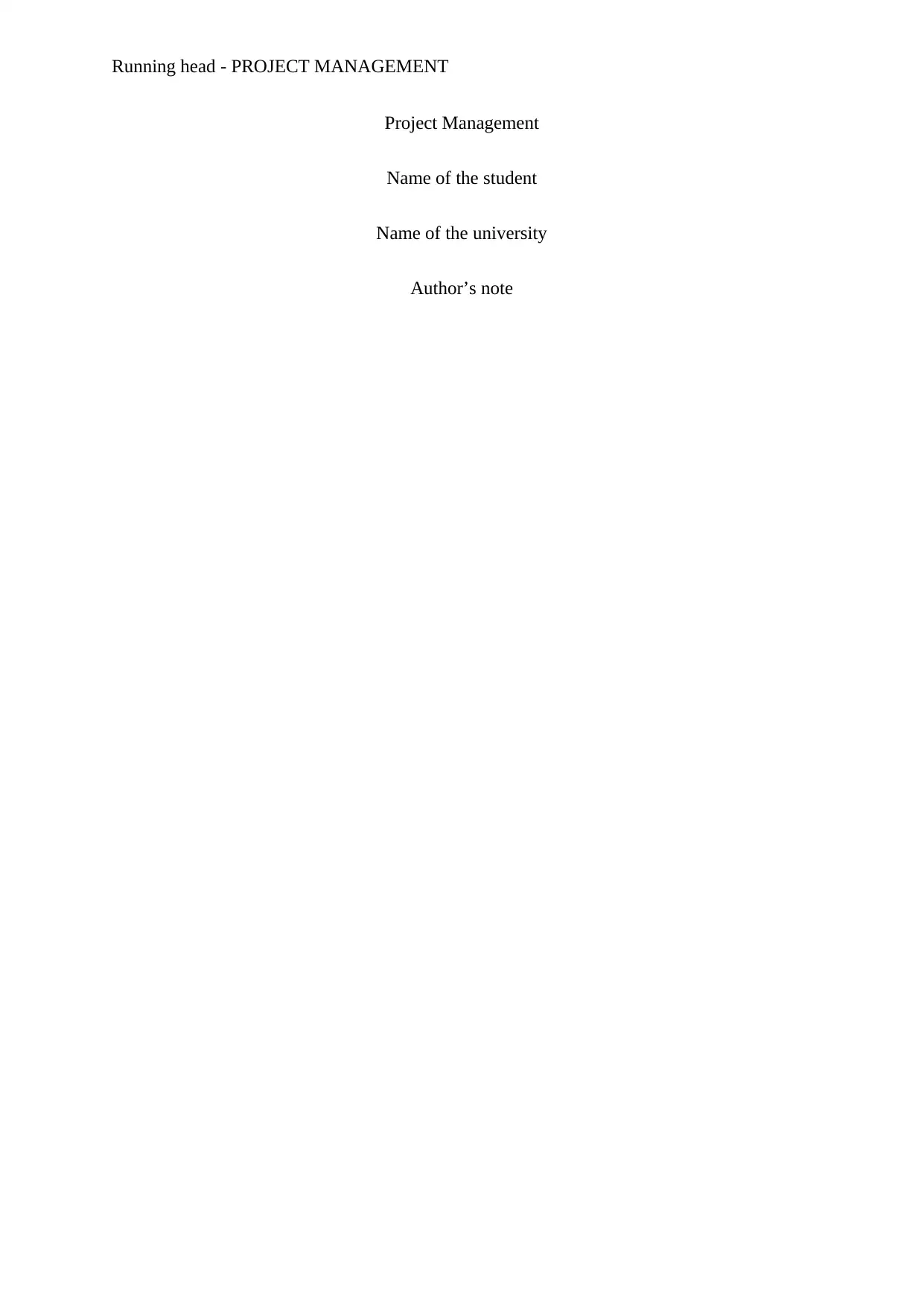
Running head - PROJECT MANAGEMENT
Project Management
Name of the student
Name of the university
Author’s note
Project Management
Name of the student
Name of the university
Author’s note
Paraphrase This Document
Need a fresh take? Get an instant paraphrase of this document with our AI Paraphraser
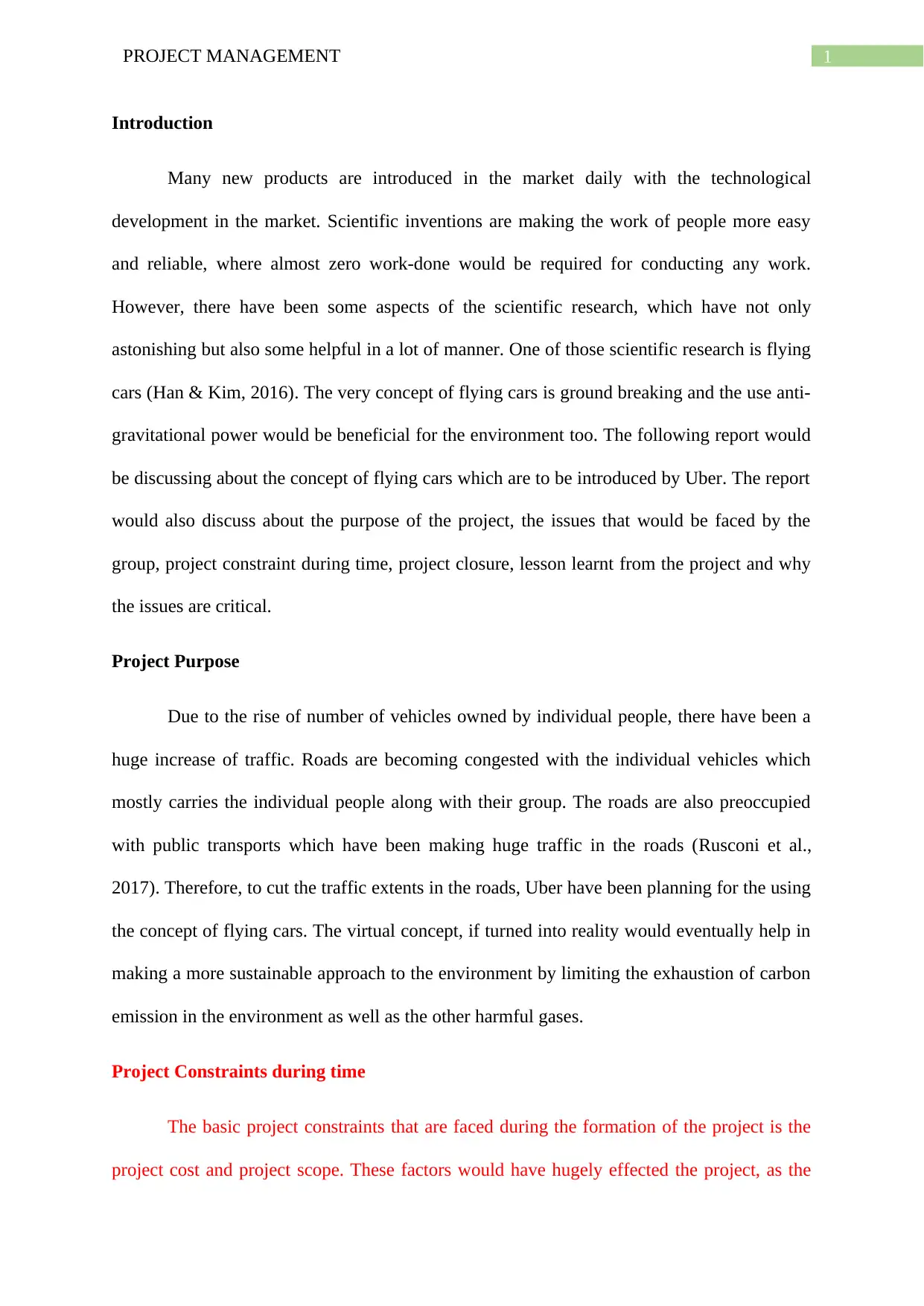
1PROJECT MANAGEMENT
Introduction
Many new products are introduced in the market daily with the technological
development in the market. Scientific inventions are making the work of people more easy
and reliable, where almost zero work-done would be required for conducting any work.
However, there have been some aspects of the scientific research, which have not only
astonishing but also some helpful in a lot of manner. One of those scientific research is flying
cars (Han & Kim, 2016). The very concept of flying cars is ground breaking and the use anti-
gravitational power would be beneficial for the environment too. The following report would
be discussing about the concept of flying cars which are to be introduced by Uber. The report
would also discuss about the purpose of the project, the issues that would be faced by the
group, project constraint during time, project closure, lesson learnt from the project and why
the issues are critical.
Project Purpose
Due to the rise of number of vehicles owned by individual people, there have been a
huge increase of traffic. Roads are becoming congested with the individual vehicles which
mostly carries the individual people along with their group. The roads are also preoccupied
with public transports which have been making huge traffic in the roads (Rusconi et al.,
2017). Therefore, to cut the traffic extents in the roads, Uber have been planning for the using
the concept of flying cars. The virtual concept, if turned into reality would eventually help in
making a more sustainable approach to the environment by limiting the exhaustion of carbon
emission in the environment as well as the other harmful gases.
Project Constraints during time
The basic project constraints that are faced during the formation of the project is the
project cost and project scope. These factors would have hugely effected the project, as the
Introduction
Many new products are introduced in the market daily with the technological
development in the market. Scientific inventions are making the work of people more easy
and reliable, where almost zero work-done would be required for conducting any work.
However, there have been some aspects of the scientific research, which have not only
astonishing but also some helpful in a lot of manner. One of those scientific research is flying
cars (Han & Kim, 2016). The very concept of flying cars is ground breaking and the use anti-
gravitational power would be beneficial for the environment too. The following report would
be discussing about the concept of flying cars which are to be introduced by Uber. The report
would also discuss about the purpose of the project, the issues that would be faced by the
group, project constraint during time, project closure, lesson learnt from the project and why
the issues are critical.
Project Purpose
Due to the rise of number of vehicles owned by individual people, there have been a
huge increase of traffic. Roads are becoming congested with the individual vehicles which
mostly carries the individual people along with their group. The roads are also preoccupied
with public transports which have been making huge traffic in the roads (Rusconi et al.,
2017). Therefore, to cut the traffic extents in the roads, Uber have been planning for the using
the concept of flying cars. The virtual concept, if turned into reality would eventually help in
making a more sustainable approach to the environment by limiting the exhaustion of carbon
emission in the environment as well as the other harmful gases.
Project Constraints during time
The basic project constraints that are faced during the formation of the project is the
project cost and project scope. These factors would have hugely effected the project, as the
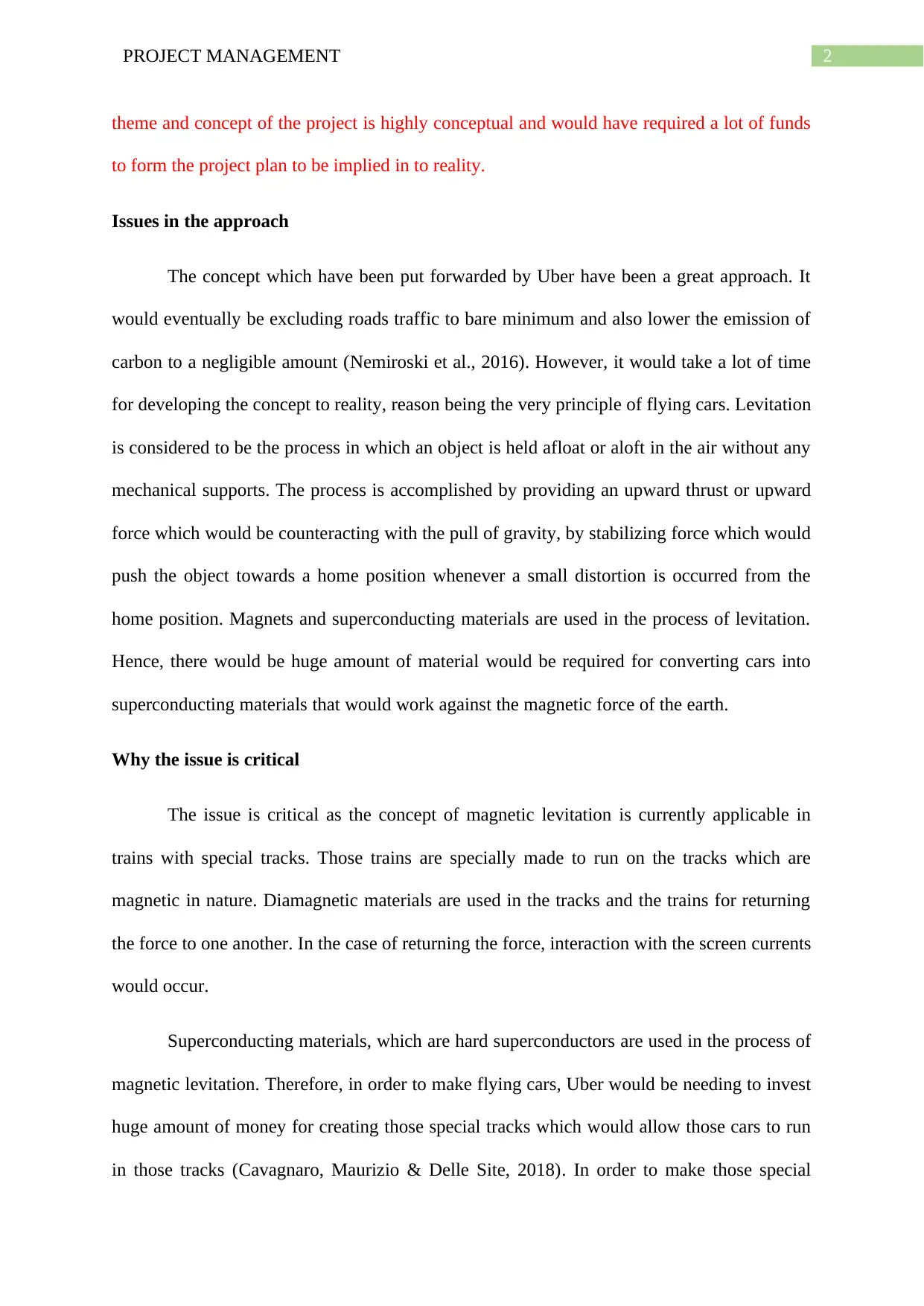
2PROJECT MANAGEMENT
theme and concept of the project is highly conceptual and would have required a lot of funds
to form the project plan to be implied in to reality.
Issues in the approach
The concept which have been put forwarded by Uber have been a great approach. It
would eventually be excluding roads traffic to bare minimum and also lower the emission of
carbon to a negligible amount (Nemiroski et al., 2016). However, it would take a lot of time
for developing the concept to reality, reason being the very principle of flying cars. Levitation
is considered to be the process in which an object is held afloat or aloft in the air without any
mechanical supports. The process is accomplished by providing an upward thrust or upward
force which would be counteracting with the pull of gravity, by stabilizing force which would
push the object towards a home position whenever a small distortion is occurred from the
home position. Magnets and superconducting materials are used in the process of levitation.
Hence, there would be huge amount of material would be required for converting cars into
superconducting materials that would work against the magnetic force of the earth.
Why the issue is critical
The issue is critical as the concept of magnetic levitation is currently applicable in
trains with special tracks. Those trains are specially made to run on the tracks which are
magnetic in nature. Diamagnetic materials are used in the tracks and the trains for returning
the force to one another. In the case of returning the force, interaction with the screen currents
would occur.
Superconducting materials, which are hard superconductors are used in the process of
magnetic levitation. Therefore, in order to make flying cars, Uber would be needing to invest
huge amount of money for creating those special tracks which would allow those cars to run
in those tracks (Cavagnaro, Maurizio & Delle Site, 2018). In order to make those special
theme and concept of the project is highly conceptual and would have required a lot of funds
to form the project plan to be implied in to reality.
Issues in the approach
The concept which have been put forwarded by Uber have been a great approach. It
would eventually be excluding roads traffic to bare minimum and also lower the emission of
carbon to a negligible amount (Nemiroski et al., 2016). However, it would take a lot of time
for developing the concept to reality, reason being the very principle of flying cars. Levitation
is considered to be the process in which an object is held afloat or aloft in the air without any
mechanical supports. The process is accomplished by providing an upward thrust or upward
force which would be counteracting with the pull of gravity, by stabilizing force which would
push the object towards a home position whenever a small distortion is occurred from the
home position. Magnets and superconducting materials are used in the process of levitation.
Hence, there would be huge amount of material would be required for converting cars into
superconducting materials that would work against the magnetic force of the earth.
Why the issue is critical
The issue is critical as the concept of magnetic levitation is currently applicable in
trains with special tracks. Those trains are specially made to run on the tracks which are
magnetic in nature. Diamagnetic materials are used in the tracks and the trains for returning
the force to one another. In the case of returning the force, interaction with the screen currents
would occur.
Superconducting materials, which are hard superconductors are used in the process of
magnetic levitation. Therefore, in order to make flying cars, Uber would be needing to invest
huge amount of money for creating those special tracks which would allow those cars to run
in those tracks (Cavagnaro, Maurizio & Delle Site, 2018). In order to make those special
⊘ This is a preview!⊘
Do you want full access?
Subscribe today to unlock all pages.

Trusted by 1+ million students worldwide
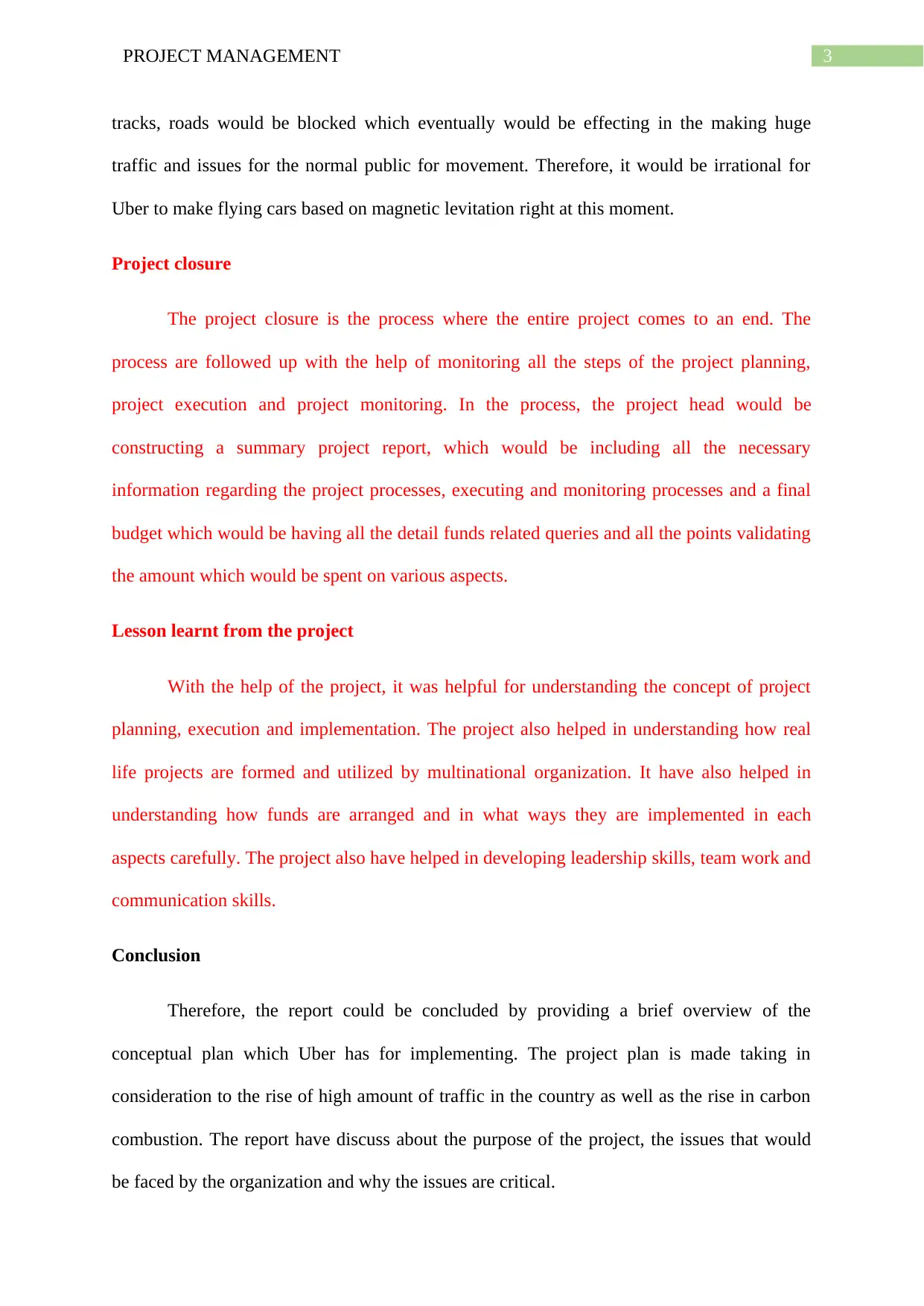
3PROJECT MANAGEMENT
tracks, roads would be blocked which eventually would be effecting in the making huge
traffic and issues for the normal public for movement. Therefore, it would be irrational for
Uber to make flying cars based on magnetic levitation right at this moment.
Project closure
The project closure is the process where the entire project comes to an end. The
process are followed up with the help of monitoring all the steps of the project planning,
project execution and project monitoring. In the process, the project head would be
constructing a summary project report, which would be including all the necessary
information regarding the project processes, executing and monitoring processes and a final
budget which would be having all the detail funds related queries and all the points validating
the amount which would be spent on various aspects.
Lesson learnt from the project
With the help of the project, it was helpful for understanding the concept of project
planning, execution and implementation. The project also helped in understanding how real
life projects are formed and utilized by multinational organization. It have also helped in
understanding how funds are arranged and in what ways they are implemented in each
aspects carefully. The project also have helped in developing leadership skills, team work and
communication skills.
Conclusion
Therefore, the report could be concluded by providing a brief overview of the
conceptual plan which Uber has for implementing. The project plan is made taking in
consideration to the rise of high amount of traffic in the country as well as the rise in carbon
combustion. The report have discuss about the purpose of the project, the issues that would
be faced by the organization and why the issues are critical.
tracks, roads would be blocked which eventually would be effecting in the making huge
traffic and issues for the normal public for movement. Therefore, it would be irrational for
Uber to make flying cars based on magnetic levitation right at this moment.
Project closure
The project closure is the process where the entire project comes to an end. The
process are followed up with the help of monitoring all the steps of the project planning,
project execution and project monitoring. In the process, the project head would be
constructing a summary project report, which would be including all the necessary
information regarding the project processes, executing and monitoring processes and a final
budget which would be having all the detail funds related queries and all the points validating
the amount which would be spent on various aspects.
Lesson learnt from the project
With the help of the project, it was helpful for understanding the concept of project
planning, execution and implementation. The project also helped in understanding how real
life projects are formed and utilized by multinational organization. It have also helped in
understanding how funds are arranged and in what ways they are implemented in each
aspects carefully. The project also have helped in developing leadership skills, team work and
communication skills.
Conclusion
Therefore, the report could be concluded by providing a brief overview of the
conceptual plan which Uber has for implementing. The project plan is made taking in
consideration to the rise of high amount of traffic in the country as well as the rise in carbon
combustion. The report have discuss about the purpose of the project, the issues that would
be faced by the organization and why the issues are critical.
Paraphrase This Document
Need a fresh take? Get an instant paraphrase of this document with our AI Paraphraser
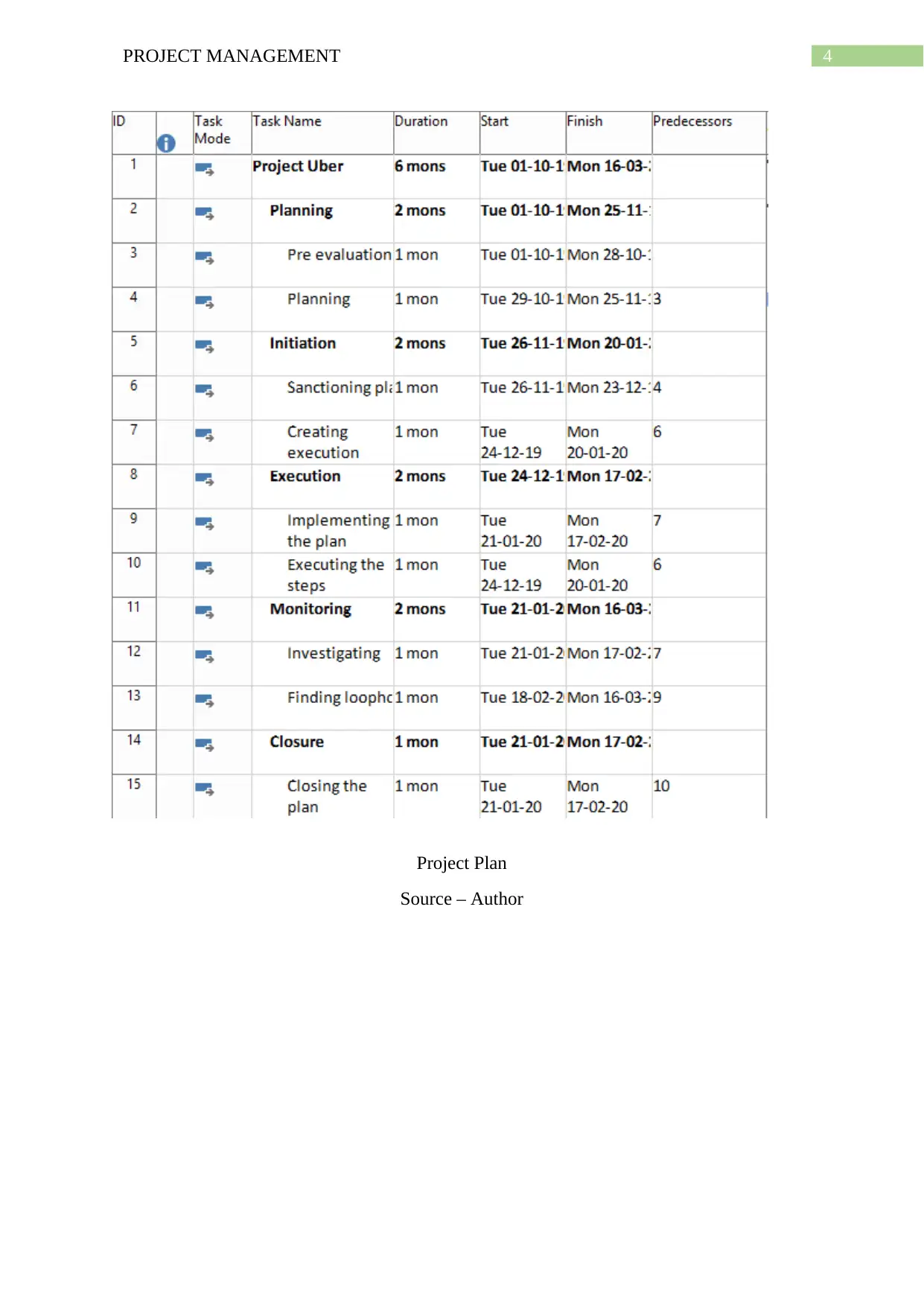
4PROJECT MANAGEMENT
Project Plan
Source – Author
Project Plan
Source – Author
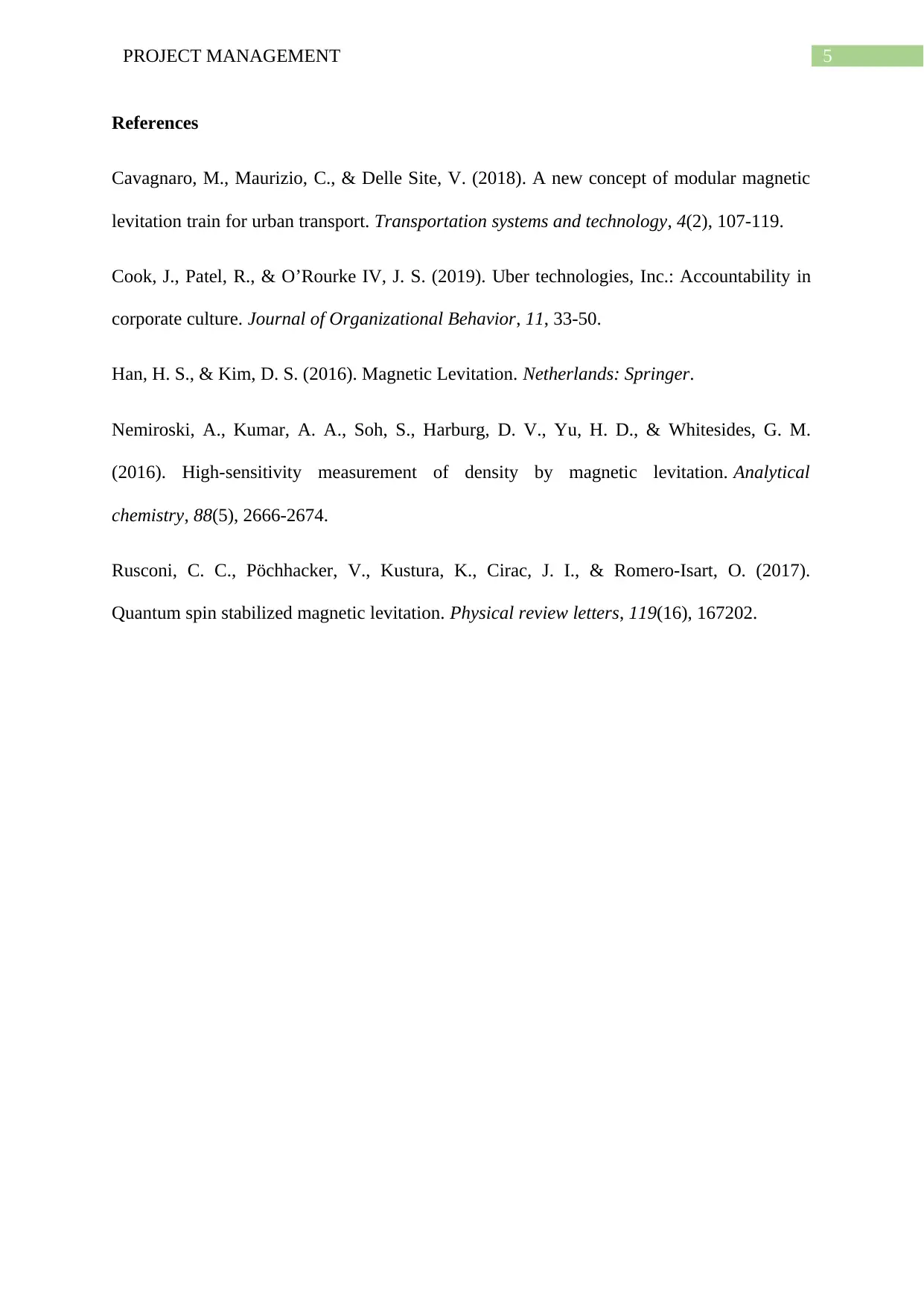
5PROJECT MANAGEMENT
References
Cavagnaro, M., Maurizio, C., & Delle Site, V. (2018). A new concept of modular magnetic
levitation train for urban transport. Transportation systems and technology, 4(2), 107-119.
Cook, J., Patel, R., & O’Rourke IV, J. S. (2019). Uber technologies, Inc.: Accountability in
corporate culture. Journal of Organizational Behavior, 11, 33-50.
Han, H. S., & Kim, D. S. (2016). Magnetic Levitation. Netherlands: Springer.
Nemiroski, A., Kumar, A. A., Soh, S., Harburg, D. V., Yu, H. D., & Whitesides, G. M.
(2016). High-sensitivity measurement of density by magnetic levitation. Analytical
chemistry, 88(5), 2666-2674.
Rusconi, C. C., Pöchhacker, V., Kustura, K., Cirac, J. I., & Romero-Isart, O. (2017).
Quantum spin stabilized magnetic levitation. Physical review letters, 119(16), 167202.
References
Cavagnaro, M., Maurizio, C., & Delle Site, V. (2018). A new concept of modular magnetic
levitation train for urban transport. Transportation systems and technology, 4(2), 107-119.
Cook, J., Patel, R., & O’Rourke IV, J. S. (2019). Uber technologies, Inc.: Accountability in
corporate culture. Journal of Organizational Behavior, 11, 33-50.
Han, H. S., & Kim, D. S. (2016). Magnetic Levitation. Netherlands: Springer.
Nemiroski, A., Kumar, A. A., Soh, S., Harburg, D. V., Yu, H. D., & Whitesides, G. M.
(2016). High-sensitivity measurement of density by magnetic levitation. Analytical
chemistry, 88(5), 2666-2674.
Rusconi, C. C., Pöchhacker, V., Kustura, K., Cirac, J. I., & Romero-Isart, O. (2017).
Quantum spin stabilized magnetic levitation. Physical review letters, 119(16), 167202.
⊘ This is a preview!⊘
Do you want full access?
Subscribe today to unlock all pages.

Trusted by 1+ million students worldwide
1 out of 6
Your All-in-One AI-Powered Toolkit for Academic Success.
+13062052269
info@desklib.com
Available 24*7 on WhatsApp / Email
![[object Object]](/_next/static/media/star-bottom.7253800d.svg)
Unlock your academic potential
Copyright © 2020–2025 A2Z Services. All Rights Reserved. Developed and managed by ZUCOL.
